by Julie McConnell | Jun 30, 2015
If you’ve been gardening for more than a few years, you may be confused by UF/IFAS recommendations that conflict with practices you’ve used for years. You aren’t imagining things, we do change recommendations based on the most current research available to help you with your agricultural endeavors.
I want to share a few common mistakes that gardeners make based on old recommendations but that research has shown are not the best choices. Check out the list below to see if you can break an old habit or two!
| Old Habit |
Current Recommendation |
| Throw a little “starter fertilizer” in the hole (or under new sod, seed, etc.) |
It is not beneficial to add fertilizer to plantinghole or under newly installed sod.Quick release (soluble) fertilizer may burn roots if added to planting hole.If applied properly, a slow release fertilizer may be applied to trees and shrubs but should be applied to the top of root ball or mulch following label instructions.Turfgrass grown from seed, sprig, or sod does not use fertilizer efficiently at planting. Wait 30 days to apply fertilizer – after roots have been established. |
| Dig the hole twice as deep and wide as the root ball for trees and shrubs |
1.5 times the width of the root ball is good, but planting too deep can be a death sentence.Planting depth should be 10% shallower than the distance from the topmost root to the base of the root ball. |
| Mulch 3-5 inches deep |
2-3 inches with a very thin layer directly over the rootball (less than 1 inch) and none touching trunk. This is the ideal amount to conserve water and suppress weeds. |
| Native and drought tolerant plants don’t need water |
All plants need water until established – depending on the type and size of the plant, weather, and soil conditions this may take months.Always plan to give a little TLC to newly installed plants no matter how tough they are supposed to be. |
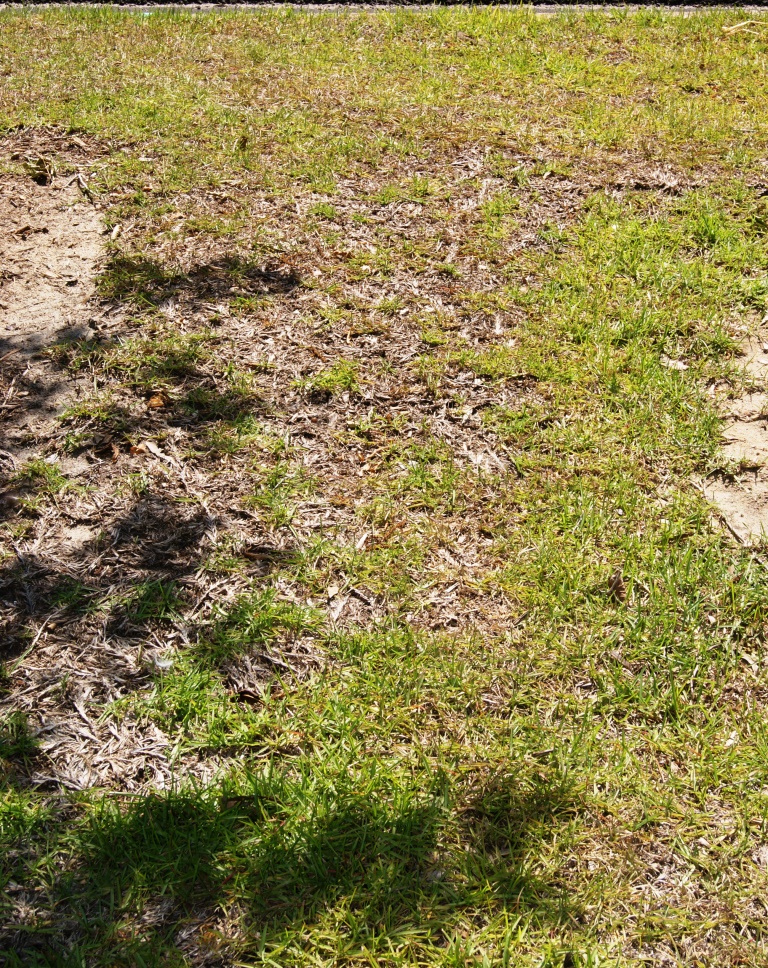
by Larry Williams | Feb 17, 2015
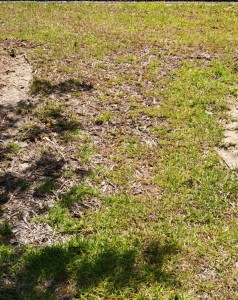
Diseased Turfgrass – Image Credit Matthew Orwat
With a few nice late winter days, many people get a good dose of spring fever. But be careful when the fever hits you. Don’t fertilize your lawn too early. The fever may turn into a lawn “headache”.
Wait to fertilize. Fertilizing while the soil is too cool can result in nutrient deficiencies such as iron deficiency causing yellow areas in the lawn. Fertilizing early can result in injury to a lawn’s roots from fertilizer burn. Or tender growth promoted by an early fertilizer application may be injured by a late frost or freeze. Have patience, allow the lawn to green up on its own and then fertilize, even if it’s not until mid April or May.
Get the numbers right. Our lawns need almost the same amount of potassium as compared to nitrogen. Getting this right can make a difference in the long-term health of your lawn. Look for a lawn fertilizer with an analysis such as 8-0-8, 10-0-10, 15-0-15, 18-0-18, 15-2-15, 16-0-8, etc. Look for a fertilizer with a 1:1 ratio of nitrogen to potassium. These numbers provide the buyer important information. The first number is the percent nitrogen (N), the second number is the percent phosphorus (P) and the third number is the percent potassium (K). Adequate potassium has been linked to reduced disease problems, drought and cold tolerance and enhanced root growth.
Use low phosphorus. Lawn grasses use much less phosphorus than nitrogen or potassium. Because of this and because phosphorus has been implicated as a cause for problems in our surface waters, it’s recommended to base phosphorus rates on the results of a reliable soil test. In absence of soil test results, select a fertilizer with 2% or less phosphorus such as 15-2-15, 8-0-8, 16-0-8, etc. It’s best to base P applications on the results of a reliable soil test.
Don’t fertilize too late. The latest month to fertilize our warm season lawn grasses in North Florida as recommended by University of Florida turfgrass researchers is mid September. If you have centipedegrass, it’s recommended to fertilize no later than July.
Measure your lawn. Most homeowners apply too much fertilizer because they do not know the square footage of their lawn. Measure the size of your lawn (front, back and side yard) and err on the side of using less fertilizer than recommended.
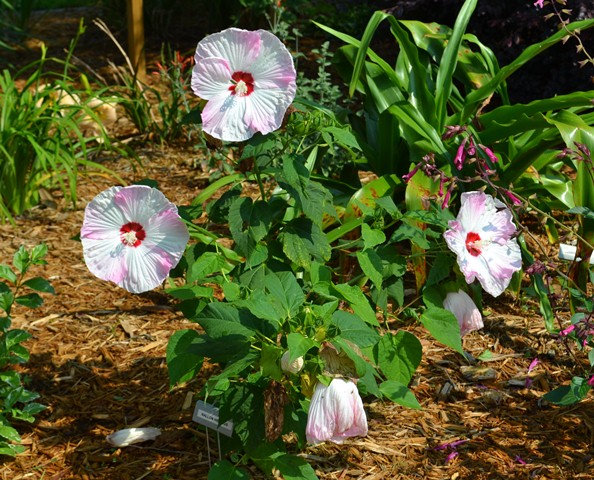
by Beth Bolles | Jun 23, 2014
In our area of Florida, soils will vary in the amount of nutrients they hold. In general, we think of our soils as nutrient poor because sand is often the highest component. Sandy soils have large pore spaces and the particles themselves do not ‘attract’ many of our nutrients. Therefore needed plant nutrients can leave a sandy soil quickly, especially when rainfall or irrigation is prevalent.
There are areas along the Panhandle that do have more quality soils that have the ability to retain some nutrients. Also, frequent fertilizer or lime applications in home landscapes can create soils with abundance of certain nutrients over time .
One nutrient that may become prevalent in routinely fertilized soils is phosphorus. We know that phosphorus is one of the big three nutrients needed by plants in order to grow and flourish. When we routinely apply phosphorus to garden beds or lawns, it can build up. Phosphorus is a nutrient that does not leave the soil as readily as other nutrients. It binds to other elements to hang around. If we keep adding phosphorus to the soil, even though there is plenty there, problems can occur. One negative impact is the potential for soils with phosphorus to wash away and pollute local water systems.
Phosphorus is absolutely necessary for plant growth. It is needed for the energy transfer which is involved in plant growth functions. Phosphorus is also important for flower and fruit formation, and root growth.
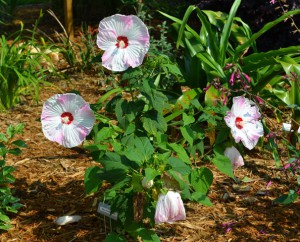
Flowering plants benefit from fertilizer but make sure your soil needs the nutrients before an application. Photo: Beth Bolles, UF IFAS Escambia Extension
There can be too much of a good thing. The key to remember, as with any nutrient, is make sure it is needed before applying it to your soil. Plant growth will not be improved beyond what is normal by adding more of any nutrient. Before you grab the bloom promoter or starter fertilizer with high phosphorus, run a soil test to accurately determine what is really needed in your soil.
by Roy Carter | Nov 4, 2013
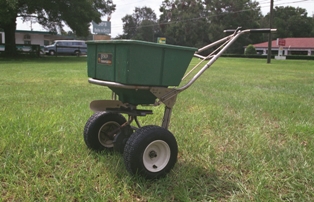
Fertilizer Spreader on lawn. Image Credit UF IFAS Extension FYN Program
Fertilizers are manufactured from a wide variety of materials to supply plant nutrients. Once these materials are mixed, it becomes difficult to distinguish the materials present. In the past, a few unscrupulous manufacturers have taken advantage of this to increase their profit. To protect consumers and legitimate manufacturers from such practices, The Florida legislature enacted the first fertilizer law in 1889 and has amended it many times since enactment. These laws regulate the manufacture and sale of fertilizer in the state.
The law requires that the manufacturer purchase and affix a label to each bag, package, container, or lot of fertilizer offered for sale in the state. The law requires that each label show specific information about the analysis and composition of the mixture or material.
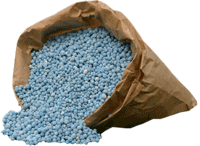
Image Credit UF IFAS
The key information comes in the guaranteed analysis section of the label. It tells the home gardener the ratio by percentage of the primary plant nutrients. The number s are in the order of these primary nutrients; Nitrogen, Phosphorus and Potassium. For example an 8-8-8 fertilizer would be eight percent nitrogen compound, eight percent phosphorus compound and eight percent potassium compound.
There’s some other information in this section of the label that may seem even more complicated but it’s also important. The label explains how much chlorine the fertilizer can contain. Chlorine can reduce the quality of some vegetable and flowers.
It informs the buyer what materials the primary plant nutrients are derived from. This can assist in determining the quality of the fertilizer.
Probably the most difficult part of the label to read, certainly the hardest part to describe, is the information listed right after the total nitrogen figure in the guaranteed analysis section. In addition the total amount of nitrogen, the label gives the amount of each of several types of nitrogen present in the fertilizer. This information will seem confusing, but it also offers a glimpse into how the fertilizer will work in specific types of soil.
Terms such as nitrate nitrogen ammoniacal nitrogen, water-soluble organic nitrogen and/or urea nitrogen can be used by plants fairly quickly. These nitrogen forms in fertilizer are great for a vegetable garden. But nitrate and water-soluble organic nitrogen are rapidly leached out of the soil so they don’t last very long. Ammoniacal and water insoluble nitrogen will stay longer in sandy soils.
Fertilizer with a high percentage of natural organic nitrogen is used by the plants slowly over a fairly long period of time. This kind of slow release fertilizer would be good for lawns helping them stay green without causing spurts of extra fast growth.
This is a complicated subject, hard to fully explain in one article. This is the take home message: almost any fertilizer purchased in Florida is a good one if it has the ingredients required for plant health and if the price is fair in terms of the total amount of plant nutrients it contains.
For more information on Florida fertilizer label contact your local UF IFAS Extension office or read this publication on the Florida Fertilizer Label.






